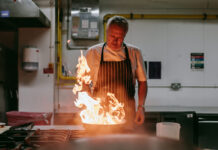Ardrossan publican is a veteran of dealing with rateable values
By Dave Hunter

Derek Mackay’s recent U-turn on business rates may have brought a sigh of relief from operators last week, but many continue to question how such dramatic increases could have been suggested in the first place.
Ardrossan publican Billy Woods is one such operator.
Woods, owner of Charlie’s Bar on the town’s Glasgow Street, is only too familiar with the workings of the rates system, having seen his own rates bills increase after the 2010 revaluation.
Prior to 2010 Charlie’s Bar had a rateable value of £13,200. The 2010 revaluation saw this more than double to £27,750.
“Like a lot of businesses, I didn’t bother that much about rates,” Woods told SLTN.
It’s all buck-passing. There’s no efficient oversight.
“I’d get my bill in. I didn’t even know how they calculated it. I just paid it. Then I got this huge increase overnight.”
It was a hammer blow to the family-owned wet sales-only business, and one Woods couldn’t fathom.
Looking at the Scottish Assessors Association (SAA) website, he could see that other, larger, premises in Ardrossan and nearby towns Saltcoats and Stevenston had lower rateable values than his premises. Because of their comparatively low rateable values, some were paying no rates at all.
“I started looking at how the rates system works,” said Woods.
“And seven years later I’m a bit of an expert in it.”

Determined to fight the increase in rateable value, and subsequent increase in his rates, Woods took his case firstly to the valuation board.
Though the office was sympathetic, he said no help was forthcoming.
The main issue, as many in the wider trade have since discovered, is the system used to calculate the rateable values of licensed premises, and the fact that, for on-trade businesses, ‘hypothetical achievable turnover’ is used to calculate the property’s rental value.
“If it’s supposed to reflect what you could rent your property for, I could easily demand £550 a week for this pub,” said Woods.
The board acknowledged that the system is not ideal.
“This is officially a deprived area, and I could rent this place out for £550 a week? You’re joking.”
Frustrated by the entire system, Woods had meetings with his MSP and local council, imploring both to raise the issue of rates at Holyrood. More sympathetic noises was the response, he said; but, again, no luck.
Letters to first minister Nicola Sturgeon and (then) finance minister John Swinney followed. Woods said neither minister responded.
Through freedom of information requests he took a sample of 27 local pubs and asked the valuation board how many had submitted turnover figures for revaluation (17), and how many that hadn’t were prosecuted under the Lands Valuation (Scotland) Act (none).
The response included an acknowledgement from the valuation board that “the current system is not ideal”.
Between correspondence with the various bodies involved in the rates system Woods said another pattern began to emerge: no one seemed willing to take responsibility.
He was told rateable values are calculated by assessors, who are independent from other branches of government; while the assessors pointed to the system they are required to operate under.
“It’s all buck-passing,” said Woods.
“To say they (the assessors) are an independent body, it’s a nonsense. Who pays for them? Who hires them?
“And they’re obliged to operate within the laws set down by the parliament. So they’re not independent.
“What it does mean is there’s no efficient oversight.”
After being a “voice in the wilderness” for the past seven years, Woods said he is relieved there has finally been some action from Holyrood.
But he insisted that the entire system needs to be overhauled.
“There is no logical justification for taxing pubs on their turnover,” he said.
“It’s a form of income tax in which you’re taxed on your gross income without allowance for expenditure.
“You’re penalised for honest endeavour, and it’s nothing less than state-sponsored extortion.”



















